Header image from National Park Service, Sequoia & Kings Canyon National Parks, California.
California was admitted to the Union on September 9, 1850 as the 31st State
Header is a picture of Sequoia National Park from the U. S. Park Service
Bird: California Valley Quail
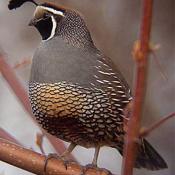
There are six native species of quail in the U.S. – bobwhite, California, mountain, Gambel’s, scaled , and Mearns quail (also called Montezuma quail). Gambel’s have a red top, California Valley quail have a blue/black top. They are offshoots of the same branch, cousins if you will.
The California quail is a highly sociable bird that often gathers in small flocks known as “coveys”. One of their daily communal activities is a dust bath. A group of quail will select an area where the ground has been newly turned or is soft, and using their underbellies, will burrow downward into the soil some one to two inches. They then wriggle about in the indentations they have created, flapping their wings and ruffling their feathers, causing dust to rise in the air. They seem to prefer sunny places in which to create these dust baths.
Flower: California Poppy
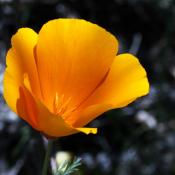
The California poppy is a species of flowering plant native to the United States and Mexico. It is an ornamental plant flowering in summer, with showy cup-shaped flowers in brilliant shades of red, orange and yellow (occasionally pink). It is also used as food or a garnish. California poppy contains chemicals that might cause relaxation and sleepiness. It has been used for insomnia, agitation, nervous disorders.
Tree: Giant Sequoia
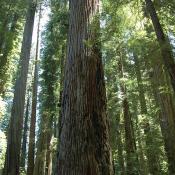
Giant Sequoia – one of three species of coniferous trees known as redwoods. Giant sequoia specimens are the most massive trees on Earth. They grow only in groves on the western slopes of the Sierra Nevada Mountains of California. They grow to an average height of 164–279 ft with trunk diameters ranging from 20–26 ft. They can live up to 3,000 years.
State Quarter
From The U.S. 50.com
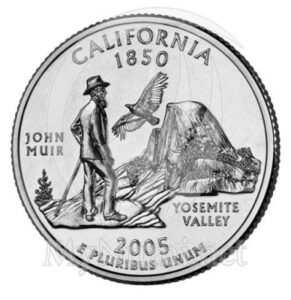
California’s quarter depicts naturalist and conservationist John Muir admiring Yosemite Valley’s monolithic granite headwall known as “Half Dome” and also contains a soaring California condor. The coin bears the inscriptions “California,” “John Muir,” “Yosemite Valley” and “1850”.
In 1849, the year before California gained statehood, the family of 11-year-old John Muir emigrated from Scotland to the United States, settling in Wisconsin. In 1868, at the age of 30, Muir sailed up the West Coast and landed in San Francisco. He made his home in the Yosemite Valley, describing the Sierra Nevada Mountains as “the Range of Light” the most divinely beautiful of all the mountain chains I have seen.” He devoted the rest of his life to the conservation of natural beauty, publishing more than 300 articles and 10 books that expanded his naturalist philosophy.
In 1890, Congress established Yosemite National Park, and in 1892 John Muir helped form the Sierra Club to protect it, serving as that organization’s President until his death in 1914.
The California condor, with a wingspan as long as nine feet, is also featured on the coin in a tribute to the successful repopulation of the once nearly extinct bird.
Capital: Sacramento
Nickname: Golden State; The Land of Milk and Honey; The El Dorado State; and The Grape State. There are more than 300,000 tons of grapes grown in California annually.
Motto: Eureka!, a Greek word translated “I have found it!” The motto was adopted in 1849 and alludes to the discovery of gold in the Sierra Nevada.
State Song: I Love You, California
List of California Facts and Trivia
The name comes from the Spanish legend of Queen Califa, ruler of an island called “California” (yes, the early explorers thought they were on an island). When Cortéz landed on Baja California, (1536) he believed he had found the island of Queen Califa, populated only by women who used gold to make tools and weapons. He wasn’t far wrong when, three centuries later, gold was discovered in California.
A Spanish ship captained by Portuguese explorer Juan Rodriguez Cabrillo visited California in 1542. Several years later, in 1579, English Explorer Sir Francis Drake landed on the coast near what is now San Francisco and claimed the land for England. However, the land was far away from Europe and European settlement didn’t really begin for another 200 years.
In 1769, the Spanish began to build missions in California. They built 21 missions along the coast in an effort to convert the Native Americans to Catholicism. They also built forts called presidios and small towns called pueblos. One of the presidios to the south became the city of San Diego while a mission built to the north would later become the city of Los Angeles.
When Mexico gained its independence from Spain in 1821, California became a province of the country of Mexico. Under Mexican rule, large cattle ranches and farms called ranchos were settled in the region. Also, people began to move into the area to trap and trade in beaver furs.
By the 1840s, many settlers were moving to California from the east. They arrived using the Oregon Trail and the California Trail. Soon these settlers began to rebel against Mexican rule. In 1846, settlers led by John Fremont revolted against the Mexican government and declared their own independent country called the Bear Flag Republic.
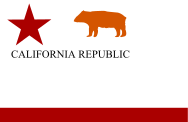 The Bear Republic didn’t last long. That same year, in 1846, the United States and Mexico went to war in the Mexican-American War. When the war ended in 1848, California became a territory of the United States. Two years later, on September 9, 1850, California was admitted into the Union as the 31st state.
The Bear Republic didn’t last long. That same year, in 1846, the United States and Mexico went to war in the Mexican-American War. When the war ended in 1848, California became a territory of the United States. Two years later, on September 9, 1850, California was admitted into the Union as the 31st state.
In 1848, gold was discovered at Sutter’s Mill in California. This started one of the largest gold rushes in history. Tens of thousands of treasure hunters moved to California to strike it rich. Between 1848 and 1855, over 300,000 people moved to California.
1854 – Sacramento became the state capital. It is named the permanent capital in 1879.
Even after the gold rush ended, people continued to migrate west to California. In 1869, the First Transcontinental Railroad made traveling west much easier. California became a major farming state with plenty of land in the Central Valley for growing all sorts of crops including apricots, almonds, tomatoes, and grapes.
1890 – Yosemite National Park was established.
1906 – A huge earthquake destroyed much of San Francisco.
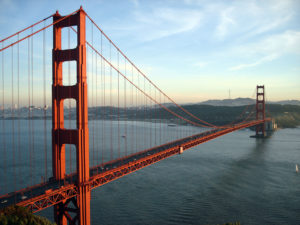 1937 – The Golden Gate Bridge in San Francisco was opened for traffic. When the steel for the Golden Gate Bridge was fabricated by Bethlehem Steel at its foundries in Pennsylvania and New Jersey, the steel was coated with a red lead primer. As the bridge towers began to rise for the Golden Gate Bridge, consulting architect Irving F. Morrow was commuting to the construction site from his home in the East Bay via ferry. He became inspired by the red lead color. Morrow undertook color studies, which resulted in the specification of the unique Golden Gate Bridge International Orange because it blended well with the nearby hills and contrasted with the ocean and sky.
1937 – The Golden Gate Bridge in San Francisco was opened for traffic. When the steel for the Golden Gate Bridge was fabricated by Bethlehem Steel at its foundries in Pennsylvania and New Jersey, the steel was coated with a red lead primer. As the bridge towers began to rise for the Golden Gate Bridge, consulting architect Irving F. Morrow was commuting to the construction site from his home in the East Bay via ferry. He became inspired by the red lead color. Morrow undertook color studies, which resulted in the specification of the unique Golden Gate Bridge International Orange because it blended well with the nearby hills and contrasted with the ocean and sky.
Morrow recognized very clearly that the Bridge color was a very important influence on its appearance in relationship to its surroundings. As the Bridge stands today, the color blends perfectly with the changing season tints of the spans’ natural setting against the San Francisco skyline and the Marin hills. Morrow concluded, “The effect of International Orange is as highly pleasing as it is unusual in the realm of engineering.”
1955 – Disneyland opened in Anaheim.
One out of every eight United States residents lives in California.
More turkeys are raised in California than in any other state in the United States.
Reputed to be the most corrupt politician in Fresno County history, Vice-leader Joseph Spinney was mayor for only ten minutes.
You’ll experience highs and lows in this great state. At 14,494 feet in height, Mt. Whitney is the highest point in the contiguous United States. It’s a mere 76 miles away from Death Valley, known as the lowest point in the contiguous United States.
Death Valley is recognized as the hottest, driest place in the United States. It isn’t uncommon for the summer temperatures to reach more than 115 degrees.
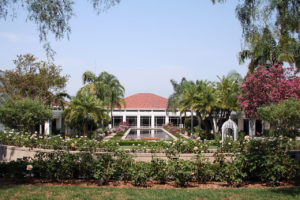 Yorba Linda is home to the Richard Nixon Library.
Yorba Linda is home to the Richard Nixon Library.
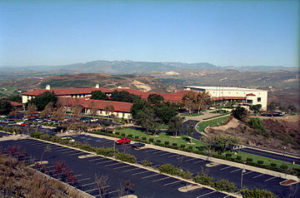 Simi Valley is the home of the Ronald Reagan Presidential Library and Museum.
Simi Valley is the home of the Ronald Reagan Presidential Library and Museum.
California has the largest economy in the states of the union. If California’s economic size were measured by itself to other countries, it would rank the 7th largest economy in the world.
It is estimated there are approximately 500,000 detectable seismic tremors in California annually.
Castroville is known as the Artichoke Capital of the World. In 1947 a young woman named Norma Jean was crowned Castroville’s first Artichoke Queen. She went on to become actress Marilyn Monroe.
The unincorporated municipality of Zzyzx is in San Bernardino County, California. It’s pronounced ZY (rhymes with EYE) – Zicks. Before 1944, Zzyzx was known as Soda Springs. Then along came this guy: Curtis Howe Springer, a self-proclaimed doctor and preacher, who founded the Zyzzx Mineral Springs Resort (he wanted it to be the very last word in the English language). Although Springer is known by the American Medical Association as the “King of Quacks,” his name for the place stuck.
The trend towards the Democratic Party is most obvious in presidential elections. From 1960 to 1988, California was a Republican leaning state, with the party carrying the state’s electoral votes in every election except for 1964. California Republicans Richard Nixon and Ronald Reagan were elected as the 37th and the 40th U.S. Presidents, respectively. However, Democrats have won all of California’s electoral votes since 1992.
Strange Laws:
Animals are banned from mating publicly within 1,500 feet of a tavern, school, or place of worship.
Bathhouses are against the law.
It is a misdemeanor to shoot at any kind of game from a moving vehicle, unless the target is a whale.
Women may not drive in a house coat.
It is illegal for a Californian to ride their bicycle through a public swimming pool.
Sunshine is guaranteed to the masses.
It is illegal to set a mousetrap without a hunting license.
In San Diego – It is illegal to shoot jackrabbits from the back of a streetcar.
People:
- Marcus Allen, football player
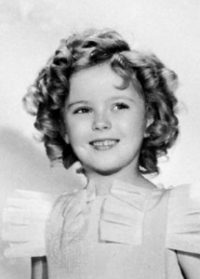 Shirley Temple Black, actress, ambassador
Shirley Temple Black, actress, ambassador- Dave Brubeck, musician
- Julia Child chef, television
- Leonardo DiCaprio, actor
- Joe DiMaggio, baseball player
- James H. Doolittle, air force general
- Isadora Duncan, dancer
- John Frémont, explorer
- Robert Frost, poet
- Jerry Garcia, guitarist, singer
 Jeff Gordon, car racer
Jeff Gordon, car racer- William Randolph Hearst, publisher
- Mariel Hemingway, actress
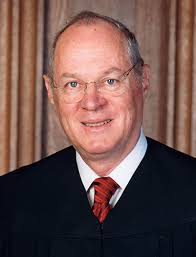 Anthony M. Kennedy, jurist
Anthony M. Kennedy, jurist- Jack London, author
- George Lucas, filmmaker
- Mark McGwire, baseball player
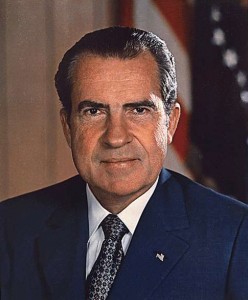 Richard M. Nixon, U.S. president
Richard M. Nixon, U.S. president- George S. Patton, Jr. general
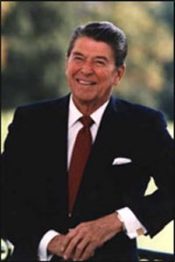 Ronald Reagan, U.S. president, born in Illinois, lived in California from age 26, Governor of California 1967-1975
Ronald Reagan, U.S. president, born in Illinois, lived in California from age 26, Governor of California 1967-1975- Robert Redford, actor
- Sally K. Ride, astronaut
- William Saroyan, author
- Lincoln Steffens, journalist, author
 John Steinbeck, author
John Steinbeck, author- Adlai Stevenson, statesman
- Earl Warren, jurist
 Venus Williams, tennis player
Venus Williams, tennis player- Eldrick “Tiger” Woods, golfer
Music
I Love You, California (state song)
California Dreamin’ by the Mamas and the Papas
California Girls by the Beach Boys
Folsom Prison Blues by Johnny Cash (Folsom Prison is 20 mi northeast of the state capital of Sacramento)
I Left My Heart in San Francisco by Tony Bennett
It Never Rains in Sunny California by Albert Hammond
Ventura Highway by America
Hotel California by the Eagles
Hollywood Nights by Bob Seger
California by Joni Mitchell
Love LA by Randy Newman
Credits
See ducksters.com
See coverhound.com
See 50 states.com
See weird facts.com
See National Park Service/Sequoia
